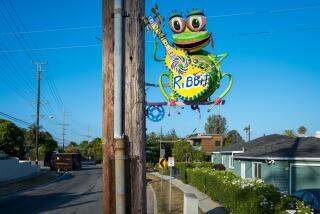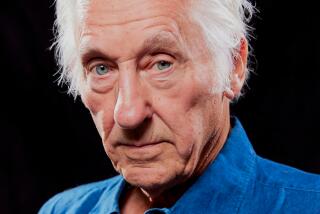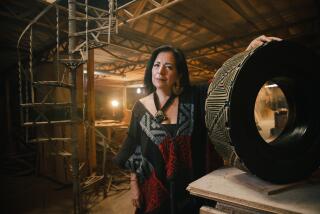‘They no longer have to rely on someone. . . . They can enhance their own lives’
- Share via
Immobile is not a word in Barbara Danielson’s vocabulary. As a child she climbed hills. When she lived in Alaska, she fished and hunted big game. Danielson was born with polio, and suffers from systemic lupus, muscular dystrophy and rheumatoid arthritis. She spent the first 18 years of her life in braces, and now needs a wheelchair to get around. Nevertheless, the 45-year-old Vista resident sets a mind-boggling pace. When she’s not at Palomar Community College taking a full course load, she is teaching art to physically disabled people at the San Diego Rehabilitation Institute at Alvarado Hospital. Times staff writer Caroline Lemke interviewed her and Don Bartletti photographed her.
My parents and my family are my supporters. I was always taught that there are no barriers. Whether it was by words or actions I can’t remember, except I was never told I couldn’t do something because I was slower walking or I was unable to climb a hill or whatever.
I fought going into a wheelchair for a while, for a long time, but it’s been almost five years now that I’m in it constantly.
I try to keep myself up physically so that I don’t become ill or worn out, because stress and fatigue are two of the worst enemies of all of these diseases. But I tell everybody that I’m not pregnant and I don’t have acne. So I do qualify it. I am OK. I am OK.
In 1984, for R&R;, I went to Palm Springs where my mother and dad have a home during the wintertime, and my dad was painting and I sidled up beside him and said, “Can I bum a canvas and some of those paints and a paintbrush?” I painted three paintings in a two-week period.
It was the first time I’d ever done anything like that. They were in oils and they didn’t look like paint-by-number, and I really received some great reviews.
I get a lot of inspiration from my surroundings. Sometimes we’re lucky enough to see some really marvelous, gorgeous, beautiful happenings, and then life turns around and gives you very garish, horrible, demeaning things to see, but we witness those also. We’ve taken an unpleasant day and made it pleasant, or vice versa. We have expanded someone’s horizon just a little further.
The same thing happens when I teach. Now, some of my students are no longer couch potatoes or paperweights. They now can bring to the canvas their own island, their own South Seas, their own mountains. They no longer have to rely on someone to take them somewhere or to bring something to them to enhance their lives. They can enhance their own lives.
I teach the handicapped or physically challenged community of San Diego County. We call the class “Artability.” I have arthritics, I have stroke victims, I have head and spinal cord injuries. I’m going to have my first mouth-painter very soon.
When the quadriplegic or paraplegic or person who has a dysfunction of some order can sit down or stand up and put brush or pencil or charcoal to paper or canvas and produce a painting all by themselves, it is the most wonderful, fulfilling feeling.
I have always thought of my body as an old carpetbag, one which was thrown off the top of a stagecoach into the dust when it reached its destination. The carpetbag has a broken clasp, the handle is frayed, it has little holes. That’s my body. But what’s inside, when you lift the latch and open it up, then you see my wit and my wisdom and my happiness and my sadness and my artability and my ability to communicate through my art.
It doesn’t make any difference what the outside of the carpetbag looks like. My body doesn’t work, but that doesn’t mean that I’m not intelligent. It doesn’t make any difference that I use mobile arm supports to hold my arms up when I do my painting because I don’t have the energy, stamina and muscle power to hold them up. I just have to have a little more around me.


